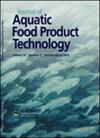不同方法对鲈鱼干燥动力学及数学模型的影响
IF 1.3
4区 农林科学
Q4 FOOD SCIENCE & TECHNOLOGY
引用次数: 0
摘要
摘要:使用烘箱和红外(IR)在60–80°C和微波(MW)在140–350W下对鲈鱼的干燥进行了研究。测定了有效水分扩散系数和活化能,并将数学模型应用于数据中。水分含量为1.8571 kg水/kg干物质,降低至0.1009–0.0798、0.0767–0.0520和0.0783–0.066 kg水/kg干燥物质,分别用于烘箱、IR和MW。烘箱、IR和MW的干燥时间分别为300–180、315–135和18–5。最兼容的型号是Midilli和Kucuk用于烤箱,Aghbashlo等人用于IR,Alibas用于MW。本文章由计算机程序翻译,如有差异,请以英文原文为准。
The Effect of Various Methods on the Drying Kinetics and Mathematical Modelling of Seabass (Dicentrarchus labrax)
ABSTRACT The drying of sea bass was examined using oven and infrared (IR) at 60–80°C, and microwave (MW) at 140–350W. Effective moisture diffusivities and activation energies were determined, and mathematical models were applied to the data. Moisture content was found as 1.8571 kg water/kg dry matter and reduced to 0.1009–0.0798, 0.0767–0.0520, and 0.0783–0.066 kg water/kg dry matter for oven, IR, and MW, respectively. Drying times were found as 300–180, 315–135, and 18–5 for oven, IR, and MW, respectively. The most compatible models found as Midilli and Kucuk for oven, Aghbashlo et al. for IR, and Alibas for MW.
求助全文
通过发布文献求助,成功后即可免费获取论文全文。
去求助
来源期刊
CiteScore
3.50
自引率
6.20%
发文量
77
审稿时长
7 months
期刊介绍:
The Journal of Aquatic Food Product Technology publishes research papers, short communications, and review articles concerning the application of science and technology and biotechnology to all aspects of research, innovation, production, and distribution of food products originating from the marine and freshwater bodies of the world. The journal features articles on various aspects of basic and applied science in topics related to:
-harvesting and handling practices-
processing with traditional and new technologies-
refrigeration and freezing-
packaging and storage-
safety and traceability-
byproduct utilization-
consumer attitudes toward aquatic food.
The Journal also covers basic studies of aquatic products as related to food chemistry, microbiology, and engineering, such as all flora and fauna from aquatic environs, including seaweeds and underutilized species used directly for human consumption or alternative uses. Special features in the journal include guest editorials by specialists in their fields and book reviews covering a wide range of topics.

 求助内容:
求助内容: 应助结果提醒方式:
应助结果提醒方式:


